Insights into Land-Use and Demographical Changes: Runoff and Erosion Modifications in the Highlands of Serbia
Abstract
:1. Introduction
2. Research Area
3. Materials and Methods
3.1. Assessment of Runoff Process Modifications
3.2. Erosion Assessment
3.3. Change Indices
3.4. Statistical Analysis
- The Pearson correlation coefficient (r) was used to quantify the degree of dependence between runoff and selected indicators. The results of this analysis revealed a statistically significant relationship between the selected indicators (α < 0.05).
- The next step involved the use of cluster analysis to differentiate the watersheds spatially based on four selected variables: CN change, Index Z, Index RP, and Index AgL). Cluster analysis (CA) is a multivariate statistical analysis method commonly used for management strategies in small catchment areas [90]. An agglomerative hierarchical method was applied, where each watershed initially stands alone as its group. The method aims to group different objects (watersheds). The method aims to maximize the similarity between watersheds within the same group [91]. As a result, watershed groups exhibit a high degree of internal (within-group) homogeneity and external (across-group) heterogeneity [92]. A hierarchical tree (dendrogram) visually represents these spatial similarities, showing the clusters determined by the analysis. The Ward method of hierarchical clustering with square Euclidean distance was employed [90].
- Since it was unclear after cluster analysis which variables were decisive for grouping the watersheds, PCA was applied. PCA identifies a small number of derived variables from a larger set of original variables [93,94,95]. The goal is to determine the minimum number of factors that explain the largest proportion of the total variance. In PCA, input variables are replaced by principal components, with each cluster from the cluster analysis corresponding to a principal component. The Kaiser–Meyer–Olkin (KMO) measure of sampling adequacy and Bartlett’s test for sphericity [96,97] were used to assess the suitability of the data for PCA. Bartlett’s sphericity test with a significance level of 95% (p < 0.05) confirms the suitability for PCA [94]. Therefore, PCA was used to perform a more detailed analysis of the clustering factors, ultimately filtering out the most important variable for each cluster.
4. Results and Discussion
4.1. Runoff Changes
- (A)
- A dominant decline in curve numbers was obtained in more than 20 watersheds located in the border areas of Eastern and Southeastern Serbia (both with an average CNDav of −1.09). These regions have experienced continuous depopulation over the last several decades [34]. The most significant CN changes in Southeastern Serbia were recorded in the Toplodolska River (CND = −2.34) and the Korbevačka River (CND = −1.98). Generally, this decline was associated with the abandonment of arable lands, which over time transitioned into woodland shrub and forest areas, potentially contributing to a slight decrease in peak discharges.
- (B)
- Minor changes in curve numbers were, on average, dominant for more than 10 watersheds in the Drina River basin. Similarly, minor changes were obtained in watersheds in Southwestern Serbia. In particular, the watersheds of Crni Rzav, Štira, Pilica, Rogačica, and Raška showed no change in hydrological response between 1990 and 2018.
| Id | Watershed | River Basin | Profile | Watershed Area (km2) | CN Change | |
|---|---|---|---|---|---|---|
| Eastern Serbia | 1 | Boljetinska | Danube | Boljetin | 75.94 | −0.70 |
| 2 | Podvrška | Danube | Milutinovac | 60.89 | −0.98 | |
| 3 | Velika Kamenička | Danube | Velesnica | 69.66 | −0.66 | |
| 4 | Zamna | Danube | Mihajlovac | 186.92 | −0.15 | |
| 5 | Koritska | Danube | Petruša | 87.05 | −1.21 | |
| 6 | Jelašnička | Danube | Jelašnica | 51.08 | −0.94 | |
| 7 | Sinja reka | Danube | Berčinovac | 11.84 | −3.21 | |
| 8 | Trgoviški Timok | Danube | Donja Kamenica | 361.28 | −0.84 | |
| Average CN change | −1.09 | |||||
| Southeastern Serbia | 9 | Toplodolska | Južna Morava | Mrtvački most | 137.81 | −2.34 |
| 10 | Dojkinačka | Južna Morava | V. Ržana | 137.43 | −1.60 | |
| 11 | Rosomačka | Južna Morava | Slavinja | 23.42 | −1.28 | |
| 12 | Visočica | Južna Morava | Braćevci | 224.85 | 0.26 | |
| 13 | Poganovska reka | Južna Morava | Poganovo | 41.17 | −1.16 | |
| 14 | Prisjanska | Južna Morava | Rasnica | 52.48 | −1.48 | |
| 15 | Lužnica | Južna Morava | Svođe | 323 | −0.13 | |
| 16 | Ravna reka | Južna Morava | Strelac | 5.59 | −1.42 | |
| 17 | Vlasina | Južna Morava | Svođe | 430.53 | −0.50 | |
| 18 | Jerma | Južna Morava | Strezimirovci | 110.85 | −0.72 | |
| 19 | Vrla | Južna Morava | Surdulica | 76.69 | −1.11 | |
| 20 | Romanovska | Južna Morava | D. Romanovce | 17.44 | −0.61 | |
| 21 | Masurička | Južna Morava | Masurica | 46.15 | −0.59 | |
| 22 | Jelašnica | Južna Morava | Jelašnica | 68.18 | −1.28 | |
| 23 | Korbevačka | Južna Morava | Klisurica | 56.43 | −1.98 | |
| 24 | Banjska | Južna Morava | Vr. Banja | 108.37 | −1.21 | |
| 25 | Ljubatska | Dragovištica | Bosilegrad | 199.01 | −0.33 | |
| Average CN change | −1.09 | |||||
| Southwest Serbia | 26 | Jošanica | Zapadna Morava | Novi Pazar | 191.71 | −0.07 |
| 27 | Godulja | Zapadna Morava | Špiljani | 99.71 | −0.33 | |
| 28 | Vidrenjak | Zapadna Morava | Krona | 137.88 | 0.40 | |
| 29 | Raška | Zapadna Morava | Novi Pazar | 471.68 | 0.02 | |
| Average CN change | 0.004 | |||||
| Western Serbia | 30 | Poblačnica | Drina | Olandići | 342.93 | −0.23 |
| 31 | Jablanica | Drina | Ž. st. Jablanica | 41.89 | 0.15 | |
| 32 | Crni Rzav | Drina | Panjak | 201.29 | 0.00 | |
| 33 | Kamišna | Drina | Kotroman | 68.26 | 0.25 | |
| 34 | Pilica | Drina | Bajina Bašta | 70.17 | 0.01 | |
| 35 | Rogačica | Drina | Rogačica | 204.41 | −0.06 | |
| 36 | Trešnjica | Drina | D. Trešnjica | 104.39 | −0.70 | |
| 37 | Bukovička reka | Drina | Vrhpolje | 16.11 | −0.43 | |
| 38 | Gračanička | Drina | Gračanica | 54.45 | −0.72 | |
| 39 | Boranjska reka | Drina | Amajić | 46.23 | 0.23 | |
| 40 | Radaljska | Drina | Radalj | 46.93 | 0.20 | |
| 41 | Štira | Drina | Loznica | 37.1 | 0.00 | |
| Average CN change | −0.11 | |||||
4.2. Changes in the Erosion Processes
4.3. Spatial Differentiation of Watersheds—The Interactive and Individual Impact of Selected Variables
5. Conclusions
Author Contributions
Funding
Data Availability Statement
Conflicts of Interest
References
- Lukić, T.; Gavrilov, M.B.; Marković, S.B.; Komac, B.; Zorn, M.; Mlađan, D.; Đorđević, J.; Milanović, M.; Vasiljević, Đ.A.; Vujičić, M.D.; et al. Classification of the natural disasters between the legislation and application: Experience of the Republic of Serbia. Acta Geogr. Slov. 2013, 53, 149–164. [Google Scholar] [CrossRef]
- Suleymanov, R.; Kamalova, R.; Suleymanov, A.; Adelmurzina, I.; Nigmatullin, A.; Khamidullin, R.; Bakieva, E.; Yurkevich, M. Pedo-climatic changes of drained floodplain soils within the forest-steppe zone of the republic of Bashkortostan (Russia). J. Geogr. Inst. Cvijic 2023, 73, 295–309. [Google Scholar] [CrossRef]
- Shabani, M.; Darvishi, S.; Rabiei-Dastjerdi, H.; Ali Alavi, S.; Choudhury, T.; Solaimani, K. An Integrated Approach for Simulation and Prediction of Land Use and Land Cover Changes and Urban Growth (Case Study: Sanandaj City in Iran). J. Geogr. Inst. Cvijic 2022, 72, 273–289. [Google Scholar] [CrossRef]
- IPCC. Intergovernmental Panel on Climate Change IPCC (2014) Climate Change 2014: Synthesis report. In Contribution of Working Groups I, II and III to the Fifth Assessment Report of the Intergovernmental Panel on Climate Change; Core Writing Team, Pachauri, R.K., Meyer, L.A., Eds.; IPCC: Geneva, Switzerland, 2014; Available online: http://www.ipcc.ch/pdf/assessment-report/ar5/syr/SYR_AR5_FINAL_full_wcover.pdf (accessed on 15 April 2024).
- Lukić, T.; Micić Ponjiger, T.; Sakulski, D.; Gavrilov, M.; Markovic, S.; Zorn, M.; Komac, B.; Mlanović, M.; Pavić, D.; Mészáros, M.; et al. Rainfall erosivity in Vojvodina (North Serbia). Acta Geogr. Slov. 2021, 61, 123–153. [Google Scholar] [CrossRef]
- Kostadinov, S.; Zlatić, M.; Dragićević, S.; Novković, I.; Košanin, O.; Borisavljević, A.; Lakićević, M.; Mlađan, D. Antropogenic Influence on Erosion Intensity Changes in Rasina River Watershed Area upstream from “Ćelije” Water Reservoir, Central Serbia. Fresenius Environ. Bull. 2014, 23, 254–263. [Google Scholar]
- Smith, G. Development of a Flash Flood Potential Index Using Physiographic Data Sets within a Geographic Information System. Master’s Thesis, Department of Geography of the University of Utah, Salt Lake City, UT, USA, August 2010. Available online: https://collections.lib.utah.edu/details?id=192329 (accessed on 15 March 2024).
- Petrović, A.M.; Kostadinov, S.; Ristić, R.; Novković, I.; Radevski, I. The reconstruction of the great 2020 torrential flood in Western Serbia. Nat. Hazards 2023, 118, 1673–1688. [Google Scholar] [CrossRef]
- Durlević, U.; Novković, I.; Lukić, T.; Valjarević, A.; Samardžić, I.; Krstić, F.; Batoćanin, N.; Mijatov, M.; Ćurić, V. Multihazard susceptibility assessment: A case study – Municipality of Štrpce (Southern Serbia). Open Geosci. 2021, 13, 1414–1431. [Google Scholar] [CrossRef]
- Pereira, C.O.; Escanilla-Minchel, R.; González, A.C.; Alcayaga, H.; Aguayo, M.; Arias, M.A.; Flores, A.N. Assessment of Future Land Use/Land Cover Scenarios on the Hydrology of a Coastal Basin in South-Central Chile. Sustainability 2022, 14, 16363. [Google Scholar] [CrossRef]
- Prokešová, R.; Horáčková, Š.; Snopková, Z. Surface runoff response to long-term land use changes: Spatial rearrangement of runoff-generating areas reveals a shift in flash flood drivers. Sci. Total Environ. 2022, 815, 151591. [Google Scholar] [CrossRef]
- Manojlović, S.; Sibinović, M.; Srejić, T.; Hadud, A.; Sabri, I. Agriculture Land Use Change and Demographic Change in Response to Decline Suspended Sediment in Južna Morava River Basin (Serbia). Sustainability 2021, 13, 3130. [Google Scholar] [CrossRef]
- Guzha, A.C.; Rufino, M.C.; Okoth, S.; Jacobs, S.; Nóbrega, R.L.B. Impacts of land use and land cover change on surface runoff, discharge, and low flows: Evidence from East Africa. J. Hydrol. Reg. Stud. 2018, 15, 49–67. [Google Scholar] [CrossRef]
- Rajan, K.; Shibasaki, R. A GIS based integrated land use/cover change model to study human-land interactions. ISPRS Arch. 2000, 33, 1212–1219. [Google Scholar]
- Kroll, F.; Haase, D. Does demographic change affect land use patterns?: A case study from Germany. Land Use Policy 2010, 27, 726–737. [Google Scholar] [CrossRef]
- Battino, S.; Lampreu, S. The Role of the Sharing Economy for a Sustainable and Innovative Development of Rural Areas: A Case Study in Sardinia (Italy). Sustainability 2019, 11, 3004. [Google Scholar] [CrossRef]
- Diaz-Sarachaga, J.M. Combining Participatory Processes and Sustainable Development Goals to Revitalize a Rural Area in Cantabria (Spain). Land 2020, 9, 412. [Google Scholar] [CrossRef]
- Macdonald, D.; Ingersoll, C.G.; Berger, T. Development and Evaluation of Consensus-Based Sediment Quality Guidelines for Freshwater Systems. Arch. Environ. Contam. Toxicol. 2000, 39, 20–31. [Google Scholar] [CrossRef]
- Nikodemus, O.; Bell, S.; Grīne, I.; Liepiņš, I. The impact of economic, social and political factors on the landscape structure of the Vidzeme Uplands in Latvia. Landsc. Urban Plan. 2005, 70, 57–67. [Google Scholar] [CrossRef]
- Petek, F. Typology of Slovenia’s Alpine Region With Emphasis on Land Use and Changes in Land Use. AGS 2005, 45, 33–52. [Google Scholar] [CrossRef]
- Griffiths, P.; Müller, D.; Kuemmerle, T.; Hostert, P. Agricultural Land Change in the Carpathian Ecoregion after the Breakdown of Socialism and Expansion of the European Union. Environ. Res. Lett. 2013, 8, 045024. [Google Scholar] [CrossRef]
- Prishchepov, A.V.; Müller, D.; Dubinin, M.; Baumann, M.; Radeloff, V.C. Determinants of Agricultural Land Abandonment in post-Soviet European Russia. Land Use Policy 2013, 30, 873–884. [Google Scholar] [CrossRef]
- Golosov, V.; Yermolaev, O.; Litvin, L.; Chizhikova, N.; Kiryukhina, Z.; Safina, G. Influence of climate and land use changes on recent trends of soil erosion rates within the Russian Plain. Land Degrad. Dev. 2018, 29, 2658–2667. [Google Scholar] [CrossRef]
- Gatarić, D.; Đerčan, B.; Živković, M.B.; Ostojić, M.; Manojlović, S.; Sibinović, M.; Lukić, T.; Jeftić, M.; Lutovac, M.; Lutovac, M. Can Depopulation Stop Deforestation? The Impact of Demographic Movement on Forest Cover Changes in the Settlements of the South Banat District (Serbia). Front. Environ. Sci. 2022, 10, 897201. [Google Scholar] [CrossRef]
- Tsegaye, L.; Bharti, R. Assessment of the effects of agricultural management practices on soil erosion and sediment yield in Rib watershed, Ethiopia. IJEST 2023, 20, 503–520. [Google Scholar] [CrossRef]
- Hinojosa, L.; Napoléone, C.; Moulery, M.; Lambin, E.F. The “mountain effect” in the abandonment of grasslands: Insights from the French Southern Alps. Agric. Ecosyst. Environ. 2016, 221, 115–124. [Google Scholar] [CrossRef]
- Hurni, H.; Tato, K.; Zeleke, G. The implications of changes in population, land use, and land management for surface runoff in the upper Nile basin area of Ethiopia. Mt. Res. Dev. 2005, 25, 147–154. [Google Scholar] [CrossRef]
- Hurni, H.; Herweg, K.; Portner, B.; Liniger, H. Soil erosion and conservation in global agriculture. In Land Use Soil Resources; Braimoh, A.K., Vlek, P.L.G., Eds.; Springer: Dordrecht, The Netherlands, 2008; pp. 41–71. [Google Scholar] [CrossRef]
- Kidane, M.; Bezie, A.; Kesete, N.; Tolessa, T. The impact of land use and land cover (LULC) dynamics on soil erosion and sediment yield in Ethiopia. Heliyon 2019, 5, e02981. [Google Scholar] [CrossRef]
- Tianming, G.; Ivolga, A.; Erokhin, V. Sustainable Rural Development in Northern China: Caught in a Vice between Poverty, Urban Attractions, and Migration. Sustainability 2018, 10, 1467. [Google Scholar] [CrossRef]
- Yu, Q.; Feng, C.C.; Xu, N.; Guo, L.; Wang, D. Quantifying the Impact of Grain for Green Program on Ecosystem Service Management: A Case Study of Exibei Region, China. Int. J. Environ. Res. Public Health 2019, 16, 2311. [Google Scholar] [CrossRef] [PubMed]
- Zhong, X.; Jiang, X.; Li, L.; Xu, J.; Xu, H. The Impact of Socio-Economic Factors on Sediment Load: A Case Study of the Yanhe River Watershed. Sustainability 2020, 12, 2457. [Google Scholar] [CrossRef]
- Horvat, U.; Žiberna, I. The Correlation Between Demographic Development and Land-Use Changes in Slovenia. AGS 2020, 60, 33–55. [Google Scholar] [CrossRef]
- Nikitović, V. Approaching Regional Depopulation in Serbia. In Geography of Serbia; World Regional Geography Book Series; Manić, E., Nikitović, V., Djurović, P., Eds.; Springer: Cham, Germany, 2022; pp. 169–181. [Google Scholar] [CrossRef]
- Joksimović, M.; Golić, R.; Krstić, F.; Malinić, V.; Vujadinović, S.; Šabić, D.; Gajić, M.; Nikolić, O.; Momčilović Petronijević, A.; Nikolić, V. Depopulacioni klaster—naselja sa 20 i manje stanovnika u Srbiji [Depopulation cluster: Settlements with 20 or less inhabitants in Serbia]. Demografija 2023, 20, 99–118. [Google Scholar] [CrossRef]
- Dabović, T.; Pjanović, B.; Tošković, O.; Djordjević, D.; Lukić, B. Experts’ Perception of the Key Drivers of Land-Use/Land-Cover Changes in Serbia from 1990 to 2012. Sustainability 2021, 13, 7771. [Google Scholar] [CrossRef]
- Pjanović, B.; Dabović, T.; Tomić, T.; Đordjević, D. Assessment of the importance of the importance of the drivers of land-use/land-cover changes on the national level: The case of Serbia. Fresenius Environ. Bull. 2022, 31, 9741–9754. [Google Scholar]
- Manojlović, S.; Srejić, T.; Sibinović, M.; Milošević, M.; Bajat, B.; Kostadinov, K. Impact of precipitation and human activities on suspended sediment transport load in the Velika Morava River Basin (Serbia). Arab. J. Geosci. 2022, 15, 1209. [Google Scholar] [CrossRef]
- Srejić, T.; Manojlović, S.; Sibinović, M.; Bajat, B.; Novković, I.; Milošević, M.V.; Carević, I.; Todosijević, M.; Sedlak, M.G. Agricultural Land Use Changes as a Driving Force of Soil Erosion in the Velika Morava River Basin, Serbia. Agriculture 2023, 13, 778. [Google Scholar] [CrossRef]
- Malić Sibinović, A.; Sibinović, M.; Ratkaj, I.; Gatarić, D.; Budović, A.; Jocić, N. Functional typology of settlements in the Srem region, Serbia. Open Geosci. 2024, 16, 20220646. [Google Scholar] [CrossRef]
- Stojanović, Ž. Agriculture in Serbia. In The Geography of Serbia; Springer: Berlin/Heidelberg, Germany, 2022; pp. 199–206. [Google Scholar]
- Stankov, U.; Klaučo, M.; Dragićević, V.; Vujičić, M.D.; Solarević, M. Assessing land-use changes in tourism area on the example of Čajetina municipality (Serbia). Geogr. Pannonica 2016, 20, 105–113. [Google Scholar] [CrossRef]
- Perović, V.; Jakšić, D.; Jaramaz, D.; Koković, N.; Čakmak, D.; Mitrović, M.; Pavlović, P. Spatio-temporal analysis of land use/land cover change and its effects on soil erosion (Case study in the Oplenac wine-producing area, Serbia). Environ. Monit. Assess. 2018, 190, 675. [Google Scholar] [CrossRef]
- Petrović, A.M. Bujične Poplave u Srbiji [Torrential Floods in Serbia]; Serbian Geographical Society: Belgrade, Serbia, 2021; Available online: https://www.researchgate.net/publication/355646649_Bujicne_poplave_u_Srbiji_-_Torrential_floods_in_Serbia (accessed on 15 April 2024).
- Milovanović, B.; Schuster, P.; Radovanović, M.; Ristić Vkanjac, V.; Schneider, C. Spatial and temporal variability of precipitation in Serbia for the period 1961–2010. Theor. Appl. Climatol. 2017, 130, 687–700. [Google Scholar] [CrossRef]
- One Geology. Available online: https://data.europa.eu/data/datasets/geologija-srbije-1-500000-projekat-jedna-geologija-onegeology?locale=en (accessed on 12 January 2024).
- Yugoslav Society of Soil Science. Soil Map of Yugoslavia; Yugoslav Society of Soil Science: Belgrade, Serbia, 1959. [Google Scholar]
- Soil Conservation Service. Hydrology, National Engineering Handbook; Soil Conservation Service: Washington, DC, USA, 1956. [Google Scholar]
- Djorović, M. Determination of soil Hydrologic class. Vodoprivreda 1984, 87, 57–60. (In Serbian) [Google Scholar]
- QGIS Development Team. QGIS Geographic Information System, Version 3.16. Open Source Geospatial Foundation Project. 2020. Available online: http://qgis.osgeo.org (accessed on 15 January 2024).
- Military Geographic Institute. Topographic Maps (1:25000). Available online: https://www.vgi.mod.gov.rs/lat/35/topografske-karte-35 (accessed on 15 January 2024).
- European Environment Agency (2016) European Digital Elevation Model (EU-DEM 25 m, Version 1.1). Available online: https://land.copernicus.eu/imagery-in-situ/eu-dem/eu-dem-v1.1 (accessed on 18 May 2022).
- European Environment Agency, CORINE (Coordination of Information on the Environment) Land Cover 2018 (Version 2020, 20u1). Available online: https://land.copernicus.eu/en/products/corine-land-cover/clc2018 (accessed on 17 May 2022).
- European Environment Agency. CORINE (Coordination of Information on the Environment) Land Cover 1990 (Version 2020, 20u1). 2020. Available online: https://land.copernicus.eu/en/products/corine-land-cover/clc-1990 (accessed on 15 September 2023).
- Aune-Lundberg, L.; Strand, G.-H. The content and accuracy of the CORINE Land Cover dataset for Norway. Int. J. Appl. Earth Obs. Geoinf. 2020, 96, 102266. [Google Scholar] [CrossRef]
- Santos-Alamillos, F.; Pozo-Vazquez, D.; Ruiz-Arias, J.; Tovar-Pescador, J. Influence of land-use misrepresentation on the accuracy of WRF wind estimates: Evaluation of GLCC and CORINE land-use maps in southern Spain. Atmos. Res. 2015, 157, 17–28. [Google Scholar] [CrossRef]
- Sangin, E.; Mishra, S.K.; Patil, P.R. Analogy Between SCS-CN and Muskingum Methods. Water Resour. Manag. 2024, 38, 153–171. [Google Scholar] [CrossRef]
- Mrozik, K. Assessment of retention potential changes as an element of suburbanization monitoring on the example of an ungauged catchment in Poznań metropolitan area (Poland). Rocz. Ochrona Sr. 2016, 18, 188–200. [Google Scholar]
- Petrović, A.M.; Novković, I.; Kostadinov, S. Hydrological analysis of the September 2014 torrential floods of the Danube tributaries in Eastern Serbia. Nat. Hazards 2021, 108, 1373–1387. [Google Scholar] [CrossRef]
- Institute for the Development of Water Resources “Jaroslav Cerni” and Republic Hydrometeorologic Service of Serbia, Hydrometeorological Data, Water Resources Assessment of Serbia, 2009 (In Serbian). Available online: https://www.srbijavode.rs/images/dokumenti/vodoprivredna_osnova_republike_srbije.pdf (accessed on 15 March 2024).
- Alewell, C.; Borrelli, P.; Meusburger, K.; Panagos, P. Using the USLE: Chances, challenges and limitations of soil erosion modelling. Int. Soil Water Conserv. Res. 2019, 7, 203–225. [Google Scholar] [CrossRef]
- Borrelli, P.; Alewell, C.; Alvarez, P.; Anache, J.; Baartman, J.; Ballabio, C.; Bezak, N.; Biddoccu, M.; Cerda, A.; Chalise, D. Soil erosion modelling: A global review and statistical analysis. Sci. Total Environ. 2021, 780, 146494. [Google Scholar] [CrossRef]
- Batista, P.V.G.; Davies, J.; Silva, M.L.N.; Quinton, J.N. On the evaluation of soil erosion models: Are we doing enough? Earth-Sci. Rev. 2019, 197, 102898. [Google Scholar] [CrossRef]
- Gavrilović, S. Inženjering o bujičnim tokovima i eroziji [Engineering of torrents and erosion]. J. Constr. (Special Issue) 1972, 1–292. (In Serbian) [Google Scholar]
- Efthimiou, N.; Lykoudi, E.; Panagoulia, D.; Karavitis, C. Assessment of Soil Susceptibility to Erosion Using the EPM and RUSLE MODELS: The Case of Venetikos River Catchment. Glob. NEST J. 2016, 18, 164–179. [Google Scholar]
- Tošić, R. Sliv akumulacije Drenova (Erozioni Procesi i Zasipanje Akumulacija); [Drenova reservoir basin (Erosion processes and filling of reservoirs with sediment)]; Geografsko društvo Republike Srpske: Banja Luka, Bosnia and Herzegovina, 2012; Special Issue 27; pp. 1–356. [Google Scholar]
- Bezak, N.; Borrelli, P.; Mikoš, M.; Jemec Auflič, M.; Panagos, P. Towards multi-model soil erosion modelling: An evaluation of the erosion potential method (EPM) for global soil erosion assessments. CATENA 2024, 234, 107596. [Google Scholar] [CrossRef]
- Ali, S.; Al-Umary, F.A.; Salar, S.G.; Al-Ansari, N.; Knutsson, S. GIS-Based Soil Erosion Estimation Using EPM Method, Garmiyan Area, Kurdistan Region, Iraq. J. Civ. Eng. Archit. 2016, 10, 291–308. [Google Scholar]
- Raza, A.; Ahrends, H.; Habib-Ur-Rahman, M.; Gaiser, T. Modeling Approaches to Assess Soil Erosion by Water at the Field Scale with Special Emphasis on Heterogeneity of Soils and Crops. Land 2021, 10, 422. [Google Scholar] [CrossRef]
- De Vente, J.; Poesen, J. Predicting soil erosion and sediment yield at the basin scale: Scale issue and semiquantitative models. Earth-Sci. Rev. 2005, 71, 95–125. [Google Scholar] [CrossRef]
- Ouallali, A.; Aassoumi, H.; Moukhchane, M.; Moumou, A.; Houssni, M.; Spalević, V.; Keesstra, S. Sediment mobilization study on Cretaceous, Tertiary and Quaternary lithological formations of an external Rif catchment, Morocco. Hydrol. Sci. J. 2020, 65, 1568–1582. [Google Scholar] [CrossRef]
- Zeghmar, A.; Marouf, N.; Mokhtari, E. Assessment of soil erosion using the GIS-based erosion potential method in the Kebir Rhumel Watershed, Northeast Algeria. J. Water Land Dev. 2022, 52, 133–144. [Google Scholar] [CrossRef]
- Haghizadeh, A.; Shui, L.T.; Godarzi, E. Forecasting sediment with erosion potential method with emphasis on land use changes at the basin. Electron. J. Geotech. Eng. 2009, 14, 1–12. [Google Scholar]
- Tavares, A.S.; Spalević, V.; Avanzi, J.C.; Alves, D. Modeling of water erosion by the erosion potential method in a pilot subbasin in southern Minas Gerais. Semina Cienc. Agrar. 2019, 40, 555–572. [Google Scholar] [CrossRef]
- Dragičević, N.; Karleuša, B.; Ožanić, N. Erosion potential method (Gavrilović Method) sensitivity analysis. Soil Water Res. 2017, 12, 51–59. [Google Scholar] [CrossRef]
- Stefanidis, S.; Stathis, D. Effect of climate change on soil erosion in a mountainous Mediterranean catchment (Central Pindus, Greece). Water 2018, 10, 1469. [Google Scholar] [CrossRef]
- Spalević, V. Assessment of soil erosion processes by using the ‘IntErO’model: A case study of the Duboki Potok, Montenegro. J. Environ. Prot. Ecol. 2019, 20, 657–665. [Google Scholar]
- Chalise, D.; Kumar, L.; Spalevic, V.; Skataric, G. Estimation of sediment yield and maximum outflow using the IntErO model in the Sarada river basin of Nepal. Water 2019, 11, 952. [Google Scholar] [CrossRef]
- Lazarević, R. Erosion in Serbia; Želnid: Belgrade, Serbia, 2009; pp. 1–294. [Google Scholar]
- Veličković, N.; Todosijević, M.; Šulić, D. Erosion Map Reliability Using a Geographic Information System (GIS) and Erosion Potential Method (EPM): A Comparison of Mapping Methods, Belgrade Peri-Urban Area, Serbia. Land 2022, 11, 1096. [Google Scholar] [CrossRef]
- Krstić, F.; Paunović, S. Changes in Soil Erosion Intensity in Jablanica Region. Zbornik radova—Geografski fakultet Univerziteta u Beogradu 2022, 70, 83–93. [Google Scholar] [CrossRef]
- Manojlović, S.; Antić, M.; Sibinović, M.; Dragićević, S.; Novković, I. Soil erosion response to demographic and land use changes in the Nišava River basin, Serbia. Fresenius Environ. Bull. 2017, 26, 7547–7560. [Google Scholar]
- Polovina, S.; Radić, B.; Ristić, R.; Milčanović, V. Spatial and temporal analysis of natural resources degradation in the Likodra River watershed. Bull. Fac. Fore. 2016, 114, 169–188. [Google Scholar] [CrossRef]
- Stefanović, I.; Ristić, R.; Dragović, N.; Stefanović, M.; Živanović, N.; Čotrić, J. Effects of Erosion Control Works: Case Study–Reservoir Celije, Rasina River Basin, the Zapadna Morava River (Serbia). Water 2024, 16, 855. [Google Scholar] [CrossRef]
- Gocić, M.; Dragićević, S.; Živanović, S.; Ivanović, R.; Martić Bursać, N.; Stričević, L.; Radivojević, A.; Živković, J. Assessment of soil erosion intensity in the Kutinska River Basin in the period 1971-2016. Fresenius Environ. Bull. 2021, 30, 10890–10898. [Google Scholar]
- USGS-Science for a Changing World (EarthExplorer). Available online: https://earthexplorer.usgs.gov (accessed on 12 September 2023).
- Novković, I. Natural Conditions as Determinants of Geohazards on the Example of Ljig, Jošanička, and Vranjskobanjska River Basins. Ph.D. Thesis, University of Belgrade, Faculty of Geography, Belgrade, Serbia, 2016. [Google Scholar]
- Basic Geological Map of Former Yugoslavia 1:100000; Federal Geological Survey: Belgrade, Serbia, 1978.
- Statistical Office of the Republic of Serbia 1961–2022. Available online: http://www.stat.gov.rs (accessed on 25 January 2024).
- Raux, J.; Copard, Y.; Laignel, B.; Fournier, M.; Masseï, N. Classification of worldwide drainage basins through the multivariate analysis of variables controlling their hydrosedimentary response. Glob. Planet. Chang. 2011, 76, 117–127. [Google Scholar] [CrossRef]
- Andrade, E.M.; Palácio, H.A.Q.; Souza, I.H.; Leão, R.A.D.; Guerreiro, M.J. Land use effects in groundwater composition of an alluvial aquifer (Trussu River, Brazil) by multivariate techniques. Environ. Res. 2008, 106, 170–177. [Google Scholar] [CrossRef]
- Chen, J.; Li, F.; Fan, Z.; Wang, Y. Integrated Application of Multivariate Statistical Methods to Source Apportionment of Watercourses in the Liao River Basin, Northeast China. Int. J. Environ. Res. Public Health 2016, 13, 1035. [Google Scholar] [CrossRef] [PubMed]
- Landau, S.; Everitt, B.S. A Handbook of Statistical Analyses Using SPSS; Chapman and Hall/CRC: Boca Raton, FL, USA, 2003. [Google Scholar]
- Pallant, J. SPSS Survival Manual: A Step-by-Step Guide to Data Analysis Using SPSS; Allen & Unwin: Crows Nest, NSW, Australia, 2005. [Google Scholar]
- Wuttichaikitcharoen, P.; Babel, M.S. Principal component and multiple regression analyses for the estimation of suspended sediment yield in ungauged basins of northern Thailand. Water 2014, 6, 2412–2435. [Google Scholar] [CrossRef]
- Bartlett, M.S. A note on the multiplying factors for various chi square approximations. J. R. Statist. Soc. 1954, 16, 296–298. [Google Scholar] [CrossRef]
- Kaiser, H. An index of factorial simplicity. Psychometrika 1974, 39, 31–36. [Google Scholar] [CrossRef]
- Ristić, R.; Gavrilović, Z.; Stefanović, M.; Malušević, I.; Milovanović, I. Effects of urbanization on the appearance of floods. In Proceedings of the International Conference BALWOIS, Ohrid, Macedonia, 23–28 May 2006; p. 7. [Google Scholar]
- Ristić, R.; Radić, B.; Vasiljević, N.; Nikić, Z. Land use change for flood protection—A prospective study for the restoration of the river Jelašnica watershed. Bull. Fac. For. 2011, 103, 115–130. [Google Scholar] [CrossRef]
- Kostadinov, S.; Braunović, S.; Dragićević, S.; Zlatić, M.; Dragović, N.; Rakonjac, N. Effects of Erosion Control Works: Case Study—Grdelica Gorge, the South Morava River (Serbia). Water 2018, 10, 1094. [Google Scholar] [CrossRef]
- García-Ruiz, J.M.; Lana-Renault, N. Hydrological and erosive consequences of farmland abandonment in Europe, with special reference to the Mediterranean region—A review. Agric. Ecosyst. Environ. 2011, 140, 317–338. [Google Scholar] [CrossRef]
- Bański, J. Agriculture of Central Europe in the Period of Economic Transformation. J. Rural. Stud. 2008, 15, 9–22. [Google Scholar]
- Sibinović, M. Structural changes in the rural planting areas of Belgrade region. Bull. Serb. Geogr. Soc. 2012, 92, 112–132. [Google Scholar] [CrossRef]
- Kokotović Kanazir, V. Small Cities—Demographic Potential of Serbia; Geographical Institute “Jovan Cvijić”, SASA: Belgrade, Serbia, 2016; pp. 1–126. [Google Scholar]
- Remote Detection of (De)population Processes in Serbia. Available online: https://depopulacija.rs/ (accessed on 19 March 2024).
- Nikitović, V.; Bajat, B.; Blagojević, D. Spatial patterns of recent demographic trends in Serbia (1961–2010). Geografie 2016, 121, 521–543. [Google Scholar] [CrossRef]
- Bogdanov, N.; Vasiljević, Z. Role of agriculture and multifunctional rural development in Serbia. APSTRACT 2011, 5, 47–55. [Google Scholar] [CrossRef]
- Gocić, M.; Dragićević, S.; Radivojević, A.; Martić Bursać, N.; Stričević, L.; Ðordević, M. Changes in soil erosion intensity caused by land use and demographic changes in the Jablanica River Basin, Serbia. Agriculture 2020, 10, 345. [Google Scholar] [CrossRef]
- Manojlović, S.; Antić, M.; Šantić, D.; Sibinović, M.; Carević, I.; Srejić, T. Anthropogenic Impact on Erosion Intensity: Case Study of Rural Areas of Pirot and Dimitrovgrad Municipalities, Serbia. Sustainability 2018, 10, 826. [Google Scholar] [CrossRef]
- Andjelković Stoiljković, M. Representation of the demographic problem of the Serbian border region in public policy. Demography 2019, 16, 103–118. [Google Scholar] [CrossRef]
- Gajić, A.; Krunić, N.; Protić, B. Classification of Rural Areas in Serbia: Framework and Implications for Spatial Planning. Sustainability 2021, 13, 1596. [Google Scholar] [CrossRef]
- Djurkin, D.; Antić, M.; Djordjević, D.Ž. Demographic Aspects of Urban Shrinkage in Serbia: Trajectory, Variety, and Drivers of Shrinking Cities. Sustainability 2023, 15, 15961. [Google Scholar] [CrossRef]
- Wynants, M.; Solomon, H.; Ndakidemi, P.; Blake, W.H. Pinpointing areas of increased soil erosion risk following land cover change in the Lake Manyara catchment, Tanzania. Int. J. Appl. Earth Obs. Geoinf. 2018, 71, 1–8. [Google Scholar] [CrossRef]
- Nouri, J.; Gharagozlou, A.; Arjmandi, R.; Faryadi, S.; Adl, M. Predicting Urban Land Use Changes Using a CA–Markov Model. Arab. J. Sci. Eng. 2014, 39, 5565–5573. [Google Scholar] [CrossRef]

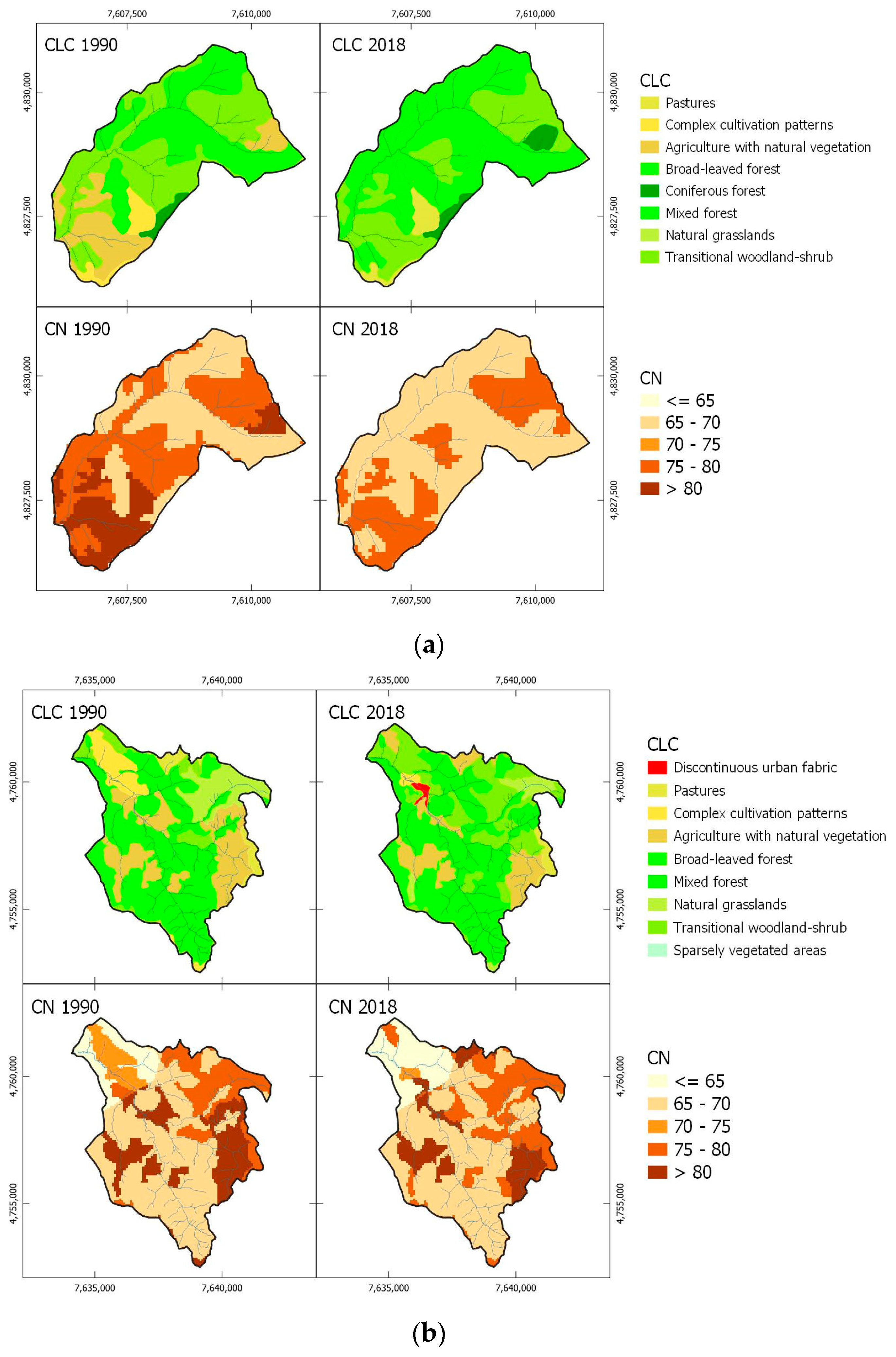
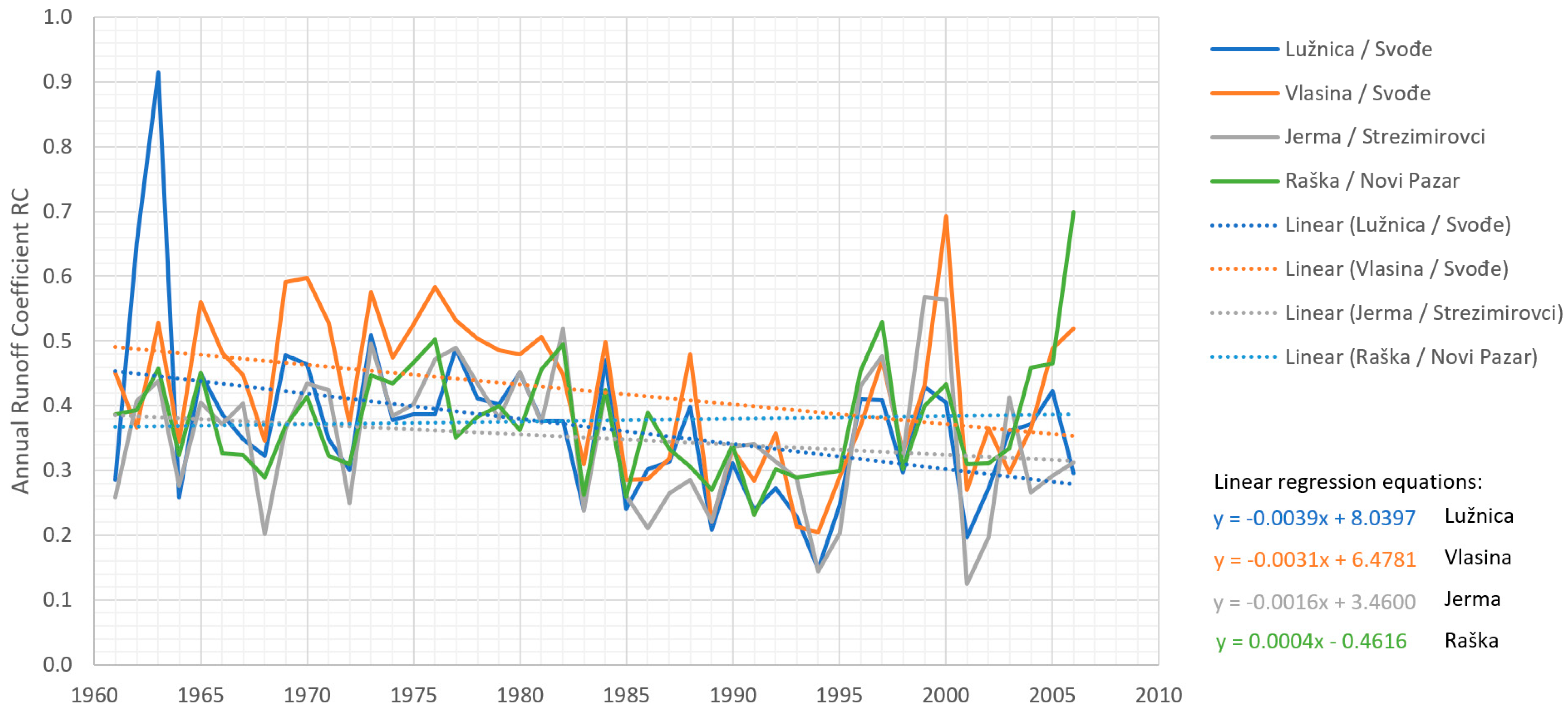
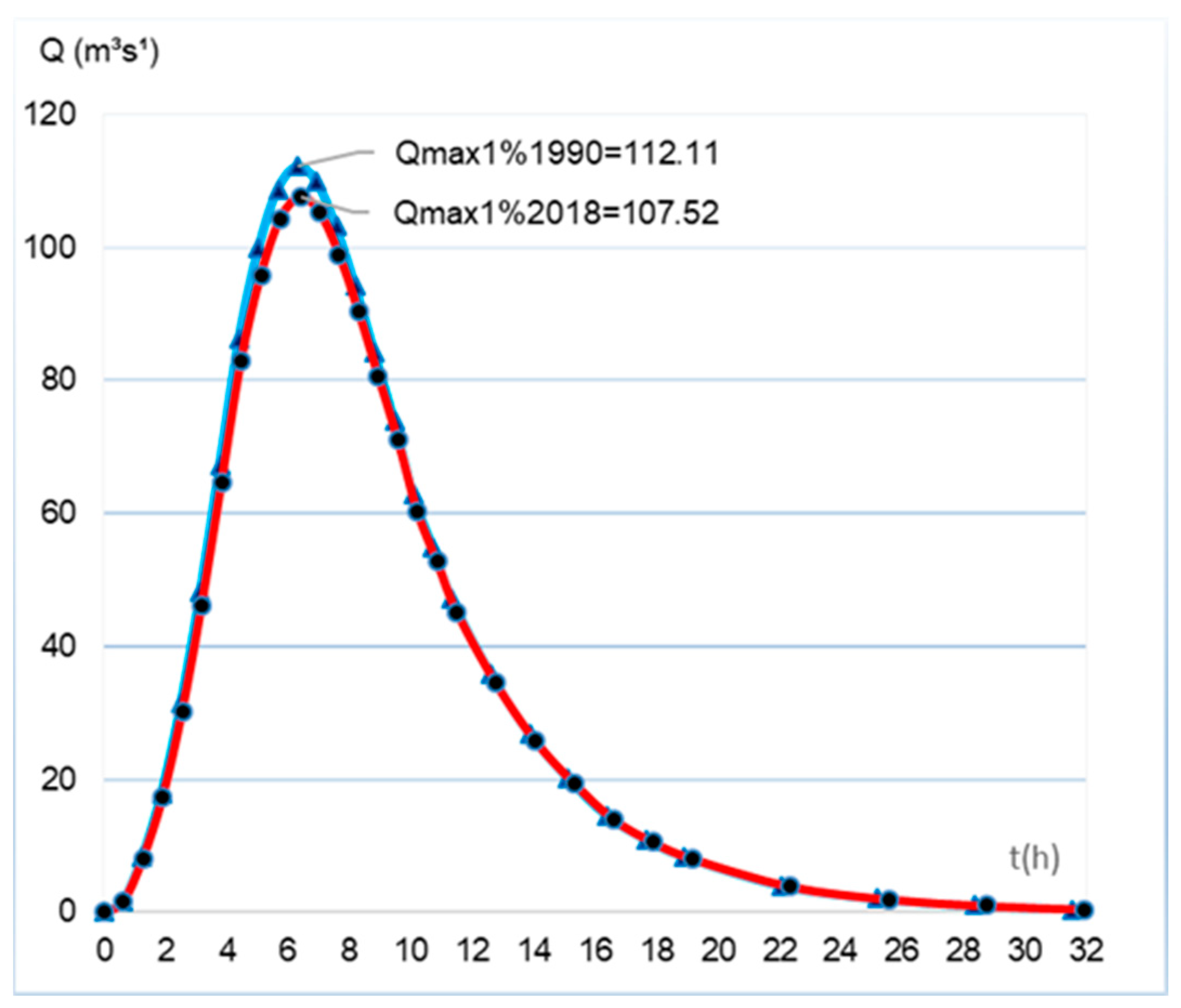
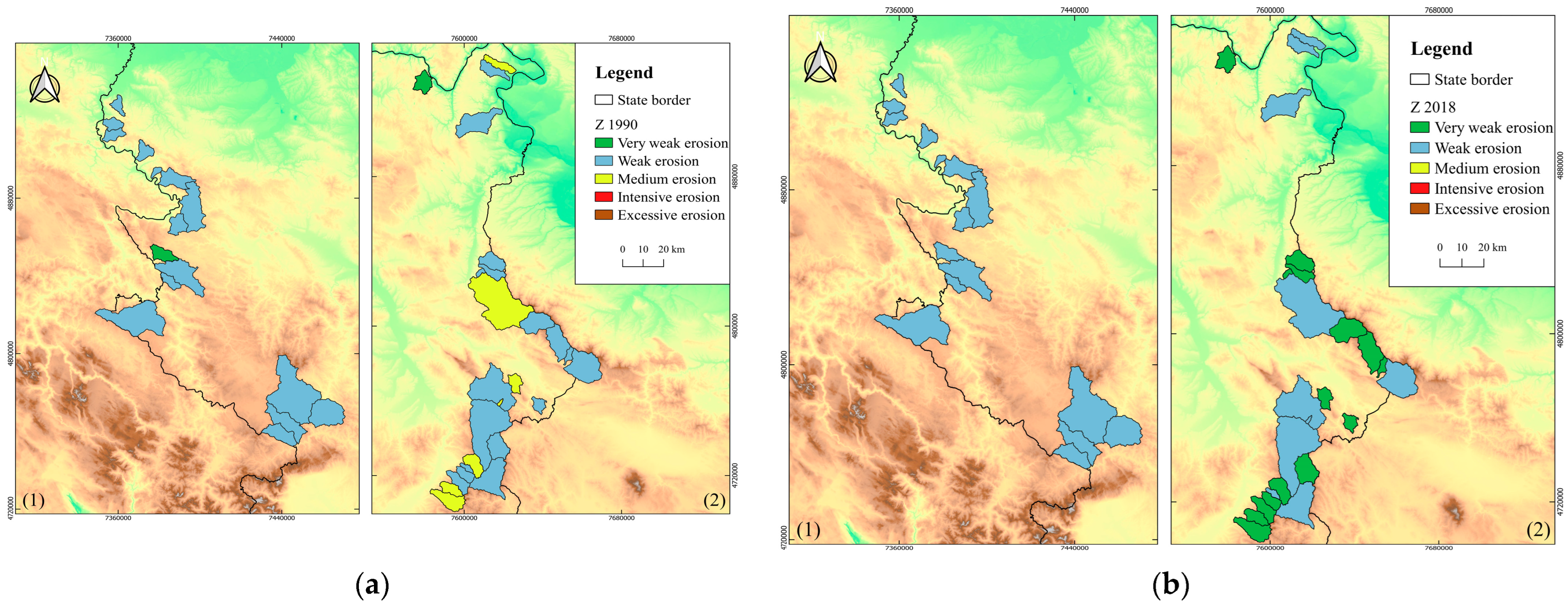


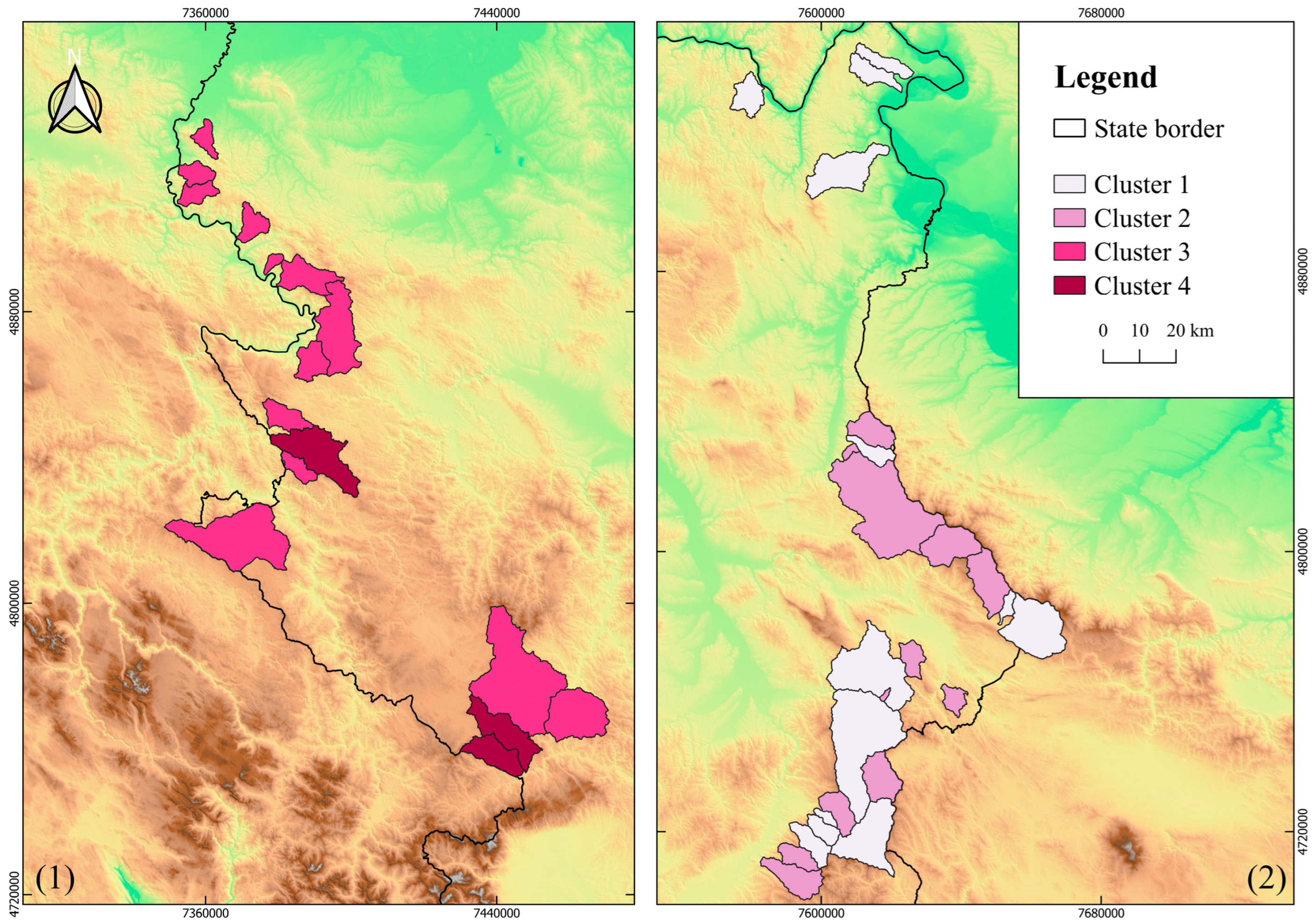
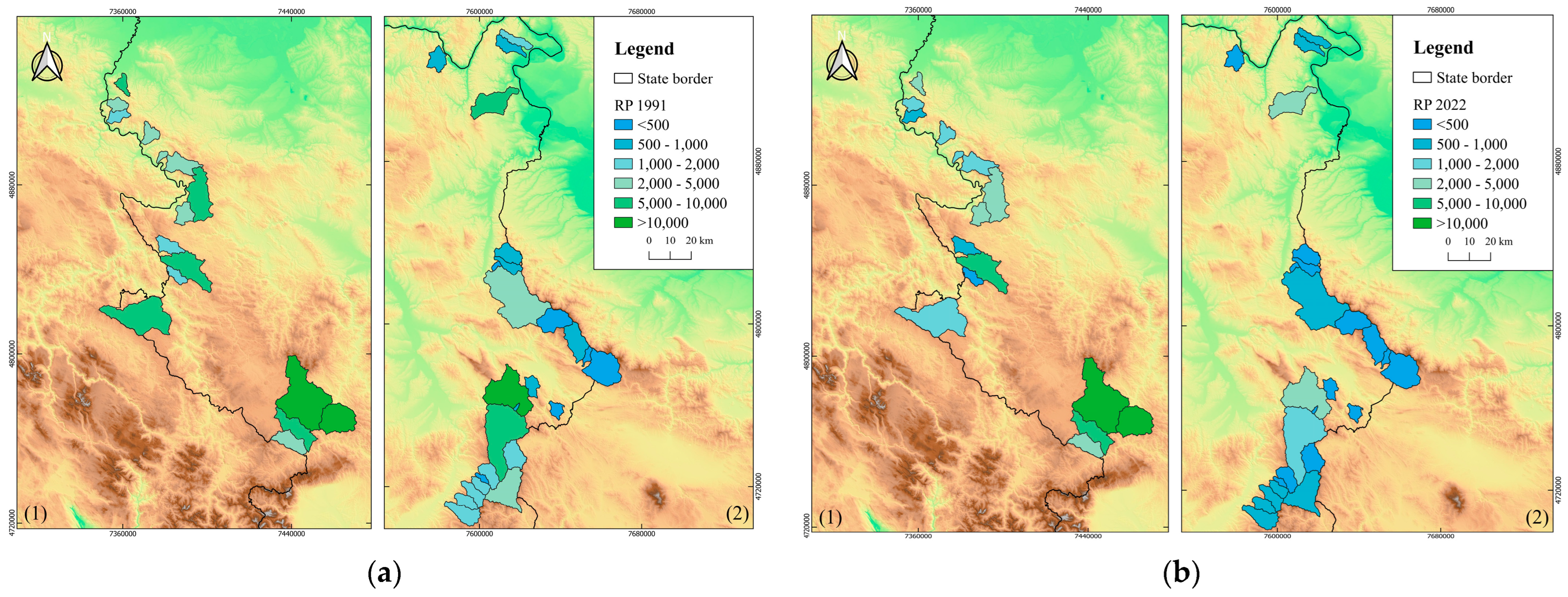
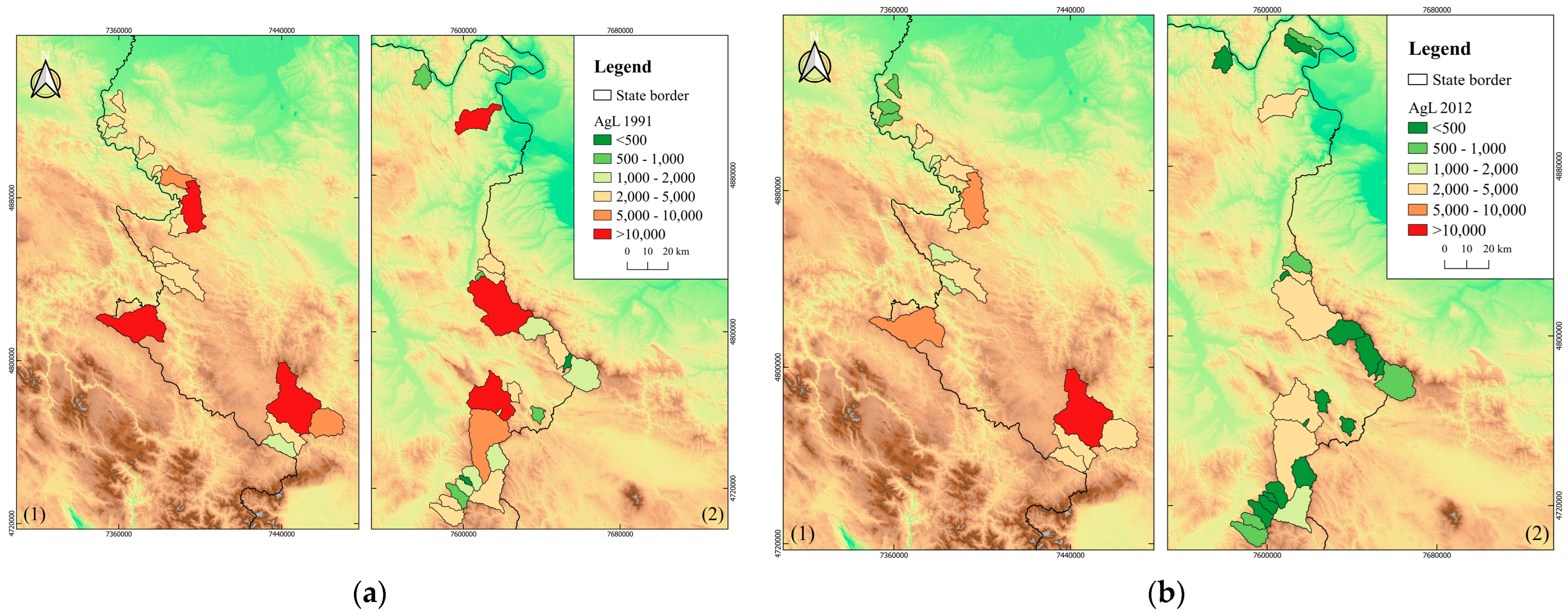

| Variables | CN Change | Index Z | Index AgL | Index RP | CN Change | Index Z | Index AgL | Index RP |
|---|---|---|---|---|---|---|---|---|
| CN change | 1 | 0 | ||||||
| Index Z | 0.847 | 1 | <0.0001 | 0 | ||||
| Index AgL | 0.491 | 0.580 | 1 | 0.0011 | <0.0001 | 0 | ||
| Index RP | 0.520 | 0.629 | 0.650 | 1 | 0.0005 | <0.0001 | <0.0001 | 0 |
| Variable | D1 (%) | D2 (%) | D3 (%) | D4 (%) |
|---|---|---|---|---|
| CN change | 62.27 (0.878) | 4.04 | 4.38 | 6.86 |
| Index Z | 29.88 | 6.84 | 8.97 | 83.03 (0.414) |
| Index AgL | 3.57 | 79.29 (0.833) | 9.05 | 4.42 |
| Index RP | 4.29 | 9.83 | 77.59 (0.808) | 5.69 |
| Cluster/Id | Watershed | D1 | D2 | D3 | D4 |
|---|---|---|---|---|---|
| C1/1 | Boljetinska reka | 0.1999 | −0.1594 | 0.0977 | −0.9710 |
| C1/3 | Velika Kamenička | 0.1732 | −1.7810 | 1.6028 | −0.4786 |
| C1/4 | Zamna | 0.9864 | −0.2913 | −0.1682 | −0.5214 |
| C1/2 | Podvrška | −0.3161 | −0.6177 | 0.3585 | −0.1738 |
| C1/6 | Jelašnička | −0.2049 | 0.8880 | −0.6241 | −0.9903 |
| C1/12 | Visočica | −0.2687 | 2.5355 | −1.8966 | −0.4537 |
| C1/11 | Rosomačka | −0.6696 | 1.0370 | −1.1265 | −0.6820 |
| C1/22 | Jelašnica | −0.8771 | 0.3448 | 0.8865 | −1.1850 |
| C1/15 | Lužnica | 1.0280 | −0.7158 | −0.4990 | 0.2680 |
| C1/20 | Romanovska | 0.3919 | 0.5456 | −1.6456 | −0.0639 |
| C1/21 | Masurička | 0.1433 | −0.1164 | 1.0036 | −0.9830 |
| C1/17 | Vlasina | 0.5028 | 0.3690 | −1.0762 | −0.2909 |
| C1/25 | Ljubatska | 0.8601 | −0.5686 | −0.7857 | −0.1617 |
| C2/8 | Trgoviški Timok | 0.1974 | −0.7228 | −0.6420 | −0.4891 |
| C2/5 | Koritska | −0.4730 | −0.5756 | −0.6541 | 0.0799 |
| C2/7 | Sinja reka | −3.9914 | −0.6878 | 0.5083 | 2.2138 |
| C2/9 | Toplodolska reka | −2.2288 | −0.6507 | −0.2408 | 0.4043 |
| C2/10 | Dojkinačka | −1.1121 | −0.6349 | −0.5827 | 0.4792 |
| C2/18 | Jerma | 0.6250 | −1.2654 | −0.4228 | −1.4356 |
| C2/13 | Poganovska reka | −0.1488 | −0.4114 | −0.4894 | −1.5743 |
| C2/23 | Korbevačka | −1.5908 | 0.1521 | −0.1043 | −1.2754 |
| C2/14 | Prisjanska | −0.5942 | −0.6965 | −0.6268 | −1.1568 |
| C2/16 | Ravna reka | −0.7003 | −0.6992 | −0.5904 | −0.2241 |
| C2/24 | Banjska | −0.3260 | −0.3219 | 0.2468 | −1.9888 |
| C2/19 | Vrla | −0.1653 | −0.7410 | −0.0723 | −1.2433 |
| C3/29 | Raška | 0.5437 | 0.9240 | 0.6850 | 0.6120 |
| C3/26 | Jošanica | 0.3800 | −0.9164 | 2.8868 | 0.2966 |
| C3/35 | Rogačica | 0.7606 | 0.2832 | −0.5220 | 1.0425 |
| C3/36 | Trešnjica | −0.4215 | 0.7649 | −0.3300 | 1.6418 |
| C3/40 | Radaljska | 1.2450 | −1.3626 | 0.8993 | 0.6618 |
| C3/30 | Poblačnica | 0.5256 | 0.4652 | −1.0454 | 1.4050 |
| C3/39 | Boranjska | 1.3925 | −1.0518 | −0.0302 | 0.8595 |
| C3/37 | Bukovička reka | 0.1068 | −0.2366 | 0.0139 | 1.6373 |
| C3/38 | Gračanička reka | −0.4084 | 0.3437 | −0.1437 | 1.6845 |
| C3/31 | Jablanica | 1.2039 | −0.0557 | −0.7800 | 0.9921 |
| C3/33 | Kamišna | 1.2375 | 0.4825 | −0.7568 | 0.9195 |
| C3/34 | Pilica | 0.7053 | 0.4867 | 0.1365 | 0.8419 |
| C3/41 | Štira | 0.8148 | −1.0126 | 0.8696 | 1.0385 |
| C4/28 | Vidrenjak | 0.7446 | 2.1180 | 1.8185 | −0.2965 |
| C4/27 | Godulja | −0.3699 | 2.3373 | 1.9070 | −0.2791 |
| C4/32 | Crni Rzav | 0.0984 | 2.2155 | 1.9349 | −0.1603 |
Disclaimer/Publisher’s Note: The statements, opinions and data contained in all publications are solely those of the individual author(s) and contributor(s) and not of MDPI and/or the editor(s). MDPI and/or the editor(s) disclaim responsibility for any injury to people or property resulting from any ideas, methods, instructions or products referred to in the content. |
© 2024 by the authors. Licensee MDPI, Basel, Switzerland. This article is an open access article distributed under the terms and conditions of the Creative Commons Attribution (CC BY) license (https://creativecommons.org/licenses/by/4.0/).
Share and Cite
Petrović, A.M.; Manojlović, S.; Srejić, T.; Zlatanović, N. Insights into Land-Use and Demographical Changes: Runoff and Erosion Modifications in the Highlands of Serbia. Land 2024, 13, 1342. https://doi.org/10.3390/land13091342
Petrović AM, Manojlović S, Srejić T, Zlatanović N. Insights into Land-Use and Demographical Changes: Runoff and Erosion Modifications in the Highlands of Serbia. Land. 2024; 13(9):1342. https://doi.org/10.3390/land13091342
Chicago/Turabian StylePetrović, Ana M., Sanja Manojlović, Tanja Srejić, and Nikola Zlatanović. 2024. "Insights into Land-Use and Demographical Changes: Runoff and Erosion Modifications in the Highlands of Serbia" Land 13, no. 9: 1342. https://doi.org/10.3390/land13091342






